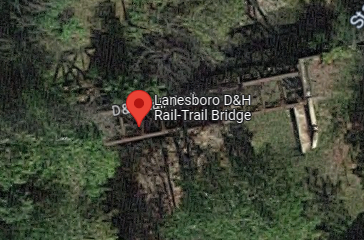B&O either daylighted or bypassed these tunnels in 1963. The abandoned Parkersburg Branch of the B&O is now the 72-mile
North Bend Rail-Trail.
#15: (
Bridge Hunter, daylighted in place)
#17: (
Bridge Hunter, see below for satellite, still exists because the new route bypassed the tunnel)
 |
One of several photos uploaded by Robert Elder to BridgeHunter-#17
"I spent about an hour in this tunnel this morning [Oct 30, 2014]. I will upload photos as soon as I can. Because this tunnel was bypassed in 1963, it retains a very high degree of historical integrity. One can clearly see that the stone is the original material and the brick was just use for patch work. Although it is not the longest tunnel on the trail, it is perhaps one of the most significant given it's relatively unaltered condition." |
This map illustrates that when an engineer designs a railroad route along a river in the mountains, she or he has to make a difficult decision concerning the height of the route. A higher route has shorter tunnels but more expensive bridges. A lower route has cheaper bridges but longer tunnels.
 |
1926 Harrisville Quad @ 62,500
|
The topo lines clearly shows where the cuts were made. The bypass for #17 is just south of the tunnel.
 |
| 1964 Cairo Quad @ 24,000 |
#17 tunnel is highlighted with the red line.
2 of 4 photos
posted by Jane Marshall-Cost with the comment: "Abandoned #17 Tunnel Cornwallis, Ritchie Co., WV."
 |
| a, cropped |
 |
| b |
 |
Neal Reynolds commented on Jane's post
from this website, a great read for rail buffs.
[But I could not find a link to the web site!] |
"I have not yet been able to determine the locations of all of the lost tunnels on the Parkersburg Branch of the B&O Railroad. But, looking at the topography between Cornwallis and Cairo, and noting the tunnel numbering sequence, the locations in this area are obvious. I have also field checked the locations of Tunnels #14-#17. Tunnel #17 is extant, just abandoned. The other tunnels between #13 (Bonds Creek Tunnel) and #19 (Silver Run Tunnel) have been daylighted." [Robert Elder comment on BridgeHunter-#18] Tunnels
#13 and
#19 not only still exist, the trail goes through them.
"North Bend Rail Trail stretches 72 miles across north-central and western West Virginia. This wilderness path takes travelers across 36 bridges and through 10 tunnels and is part of the 5,500-mile American Discovery Trail, which spans the length of the United States. The trail has become one of the most renowned recreational trails through the Appalachians, and is known for its mountainous scenery and varied views of shaded tree canopies, rock cuts and farmland. Highlights include a 2,297-foot tunnel and the 'haunted' Silver Run Tunnel." [
wvstateparks]
The name of the longest tunnel is Central Station Tunnel, but I have not been able to find its location. [
traillink, specifies a length of 2,207'.]
I had to hunt for a while, but I did find an overview map of the trail.
Bonus: #22 (Rodimer)
Austin Greenlee
posted three photos with the comment: "Rodimer's Tunnel."
 |
| 1 |
 |
| 2 |
 |
| 3 |
 |
| 1957 Petroleum Quad @ 24,000 |






































%20-%20YouTube.png)











